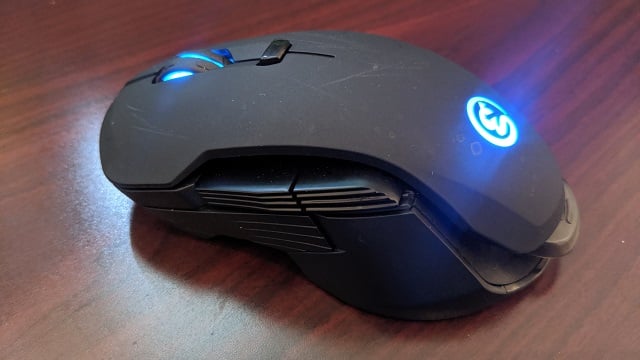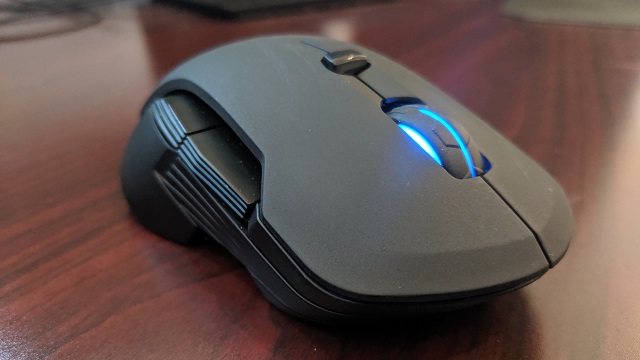These days, it’s hard for any one gaming mouse to stand out from the pack. GameSir’s GM300 might not stand head or shoulders above the rest, but it stands firmly in line with the competition.
From stem to stern, it’s a surprisingly good mouse. It doesn’t suffer from the same identity crisis that haunts GameSir’s GK300 keyboard; instead, the GM300 knows it’s a gaming mouse through and through.
Everything you’d expect to find on a modern input device you’ll find here. From customizable RGB lighting to tunable DPI and programmable macros to responsive switches, the mouse clicks all the right buttons to be considered a real contender.
Aside from its low $49.99 price tag, it’s also worth noting that the GM300 has both wired and wireless configurations — all in a single unit. More importantly, though, it is an ambidextrous mouse. Anyone looking for such accessibility knows all too well what a rare commodity that is. It’s conceivable that fact alone will push this mouse to the top of the pack for some.

Design
The GM300 comes in all-black. The top shell features a matte finish, while the sides are a bit glossier, although not exactly brushed. The GM300’s RGB lighting comes from the GameSir logo positioned at the back of the mouse, as well as from the mousewheel at the front.
The top shell is easily scratchable by even a fingernail, which I noticed while trying to remove a small splash stain. The rest of the mouse, however, isn’t prone to scratching.
Because of its steeper back arch, the GM300 is best suited for palm and claw-grip styles, moving faster, of course, with the latter. However, at a staggering 340 grams with the weights installed, moving fast with the mouse is relative. Removing the weights brings it to a 328 grams.
In a nice touch, the sides of the mouse can be altered with different side plates, all of which come in the box. Everything pops on and off very easily, and aside from flat side covers, GameSir also provides two thumb rests. The mouse’s polygonal weights are on either side of the mouse, positioned underneath near the mouse’s feet. These also easily pop out, although neither lighter nor heavier weights are provided.
There are eight buttons on the mouse: RMB, LMB, the mousewheel, the DPI switch just below it, and two lateral buttons on each side. The RMB and LMB are OMRON switches rated for 20 million clicks, which is in line with some other competing mice.
If using the mouse in wired mode, there is a port at the front of the mouse for the cable. At the back of the mouse, you’ll find a space underneath the top shell for holding the wireless dongle.
Flip the mouse over to find the on/off switch for wireless mode as well as a switch for releasing the wireless dongle holder. However, it’s just as easy to pull the dongle out without using the switch, so I found it mostly useless in my time with the mouse.
On the bottom, you’ll also find the GM300’s three feet, as well as its PMW3389 sensor in the middle.
Features
Unlike the GK300, which featured no extra software, the GM300 has a rather robust set of features available via G-Core, which allows for myriad customizability options.
Opening up the program, which can be downloaded from the GameSir website, you’re met with four different categories.
In Basic Settings, you can change the mouse’s native DPI, assigning custom DPIs to any of the GM300’s five profiles. Out of the box, the mouse is set to 400,800,1,600, 3,200, and 16,000. GameSir’s marketing materials say the mouse can achieve 16,000 DPI at its highest setting, although G-Core’s slider “allows” for up to 32,000 DPI, which is patently absurd.
Despite the efficacy of such a high DPI option, you can also change the GM300’s polling rate here (from 125Hz to 1,000Hz), the pointer movement speed from 1-10, and the mouse’s overall acceleration, with values ranging from 1-10.
In Key Settings, you can completely change the function of any of the GM300’s eight buttons. From basic a click to volume mute, to DPI cycle and Windows functions, there are more than 40 different options available. This is where users can also change the mouse from a right-hand mouse to a left-mouse at the click of a button.
Light settings are self-explanatory. If you’ve used an RGB mouse before, you get all of the same functionality and 16.8 million colors from the GM300 as you do from other such mice. The only difference here is that there are only three different lighting profiles: static, neon, seven-color breathing. You can also set a timer to automatically turn off the mouse’s RGB after a certain period of time, which is a nice quality of life touch.
And finally, there is a bevy of macros available as well. As with other software that provides macro customization, you can name macros, record them, add default (or no) delay, and assign them to specific profiles. Configuring, recording, inserting, and deleting macros is a cinch.

Functionality
In-game and at work, the GM300 was smooth and mostly accurate. At higher DPIs, I did notice a bit of inaccuracy, specifically when stopping on specific objects, icons, and buttons. However, in games like Killing Floor 2 and Battlefield 5, the mouse was well accurate enough and didn’t prove to be problematic. That was doubly so in wired mode.
I did experience some rather intolerable jumping when I first used the mouse in wireless mode at work, where I’m using an older computer and three different wireless devices at once. At home, on a newer computer and the same amount of wireless devices, I didn’t experience any jumping. This makes me believe my work comp has more electronic noise clouding the GM300 signal, rather than it being an issue with the mouse itself.
Aside from that, all of the buttons are mostly easy to get to, although the side buttons, specifically the ones closer to the front of the mouse, can be difficult to reach when using a claw-grip. The RMB and LMB are responsive from the front of the mouse to the backends of the side buttons, about 3/4 down the back of the mouse.
The GM300’s lift-off distance is about average and useful for someone like me who makes too many micro-movements and micro-lifts while playing. However, there isn’t a way to adjust the LoD, as there is with a mouse such as the SteelSeries Rival 700.
Pros:
- Ambidextrous mouse
- Provides wired and wireless capabilities
- Highly customizable with weights and side panels
- Responsive, reprogrammable switches
- Wireless dongle holder
Cons:
- Side buttons can be a bit hard to reach
- Top shell can be easily scratched
- Heavier than most mice, even with the weights removed
- Wireless on/off button can be a bit hard to switch
Since we review games and hardware on a full-point scale, I struggled with the final score on the GM300. Ultimately, I decided to go with an 8 because at the end of the day, a lot of my qualms with the mouse were pithy or circumstantial. Overall, the GM300 is a great mouse.
It might not stand out from the competition in a big way, but that doesn’t mean it isn’t worth some attention. With multiple customization options, including ambidextrous handling, both wired and wireless functionality, and one of the better PixArt sensors in the PMW3389, giving it a 7 just doesn’t feel right.
Here are the mouse’s specs:
| Connection Type(s) | Wired/Wireless (2.4GHz) |
| Platforms | PC/macOS |
| Adjustable 5-Level DPI | 400/800/1,600/3,200/16,000 |
| Frame Rate | 500fps |
| Acceleration | 50g |
| Polling Rate | 125Hz/250Hz/500Hz/1,000Hz |
| Switch Lifespan | 20 million clicks |
| Switch Type | OMRON |
| Connectivity | USB Type-C |
| Cable Length | 5.91ft |
| Weight w/ Weights | 340 grams |
| Weight w/o Weights | 328 grams |
[Note: A GM300 review unit was provided by GameSir for the purpose of this review.]







Published: Jun 7, 2019 12:06 pm